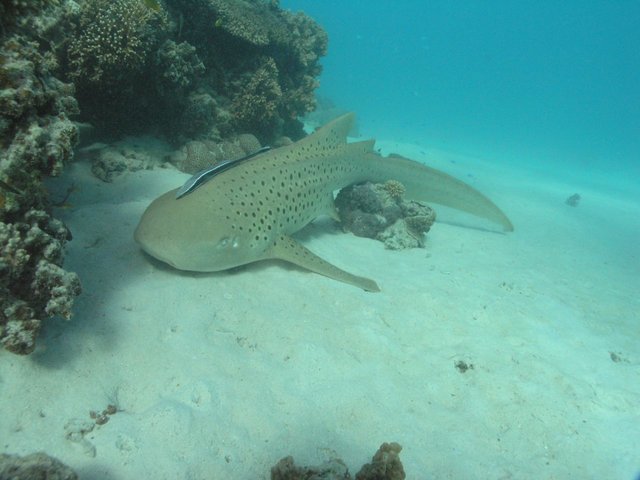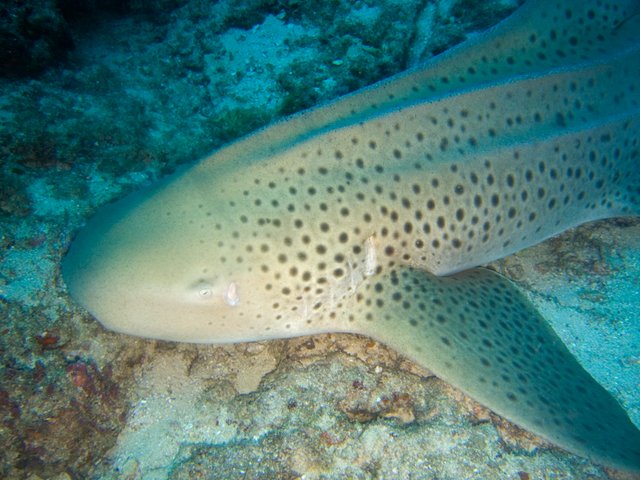A female zebra shark has produced three baby sharks without a mate to fertilize her eggs
If you are reading science news these days, you have probably already seen a few articles about the female zebra shark (Stegostoma fasciatum) who had a litter of pups without having a mate. For the rest of you; you are about to read about a pretty cool event that is actually very rare in most species!
But first, let us take a quick look at the zebra shark! They are the only member of the family Stegostomatidae, and due to fishing they are considered endangered. They are found in the Indo-Pacific ocean, searching for food near coral reefs and sandy flats. Their morphology is rather unique, with dark spots all over their body. A lot of people refer to them as leopard sharks, which I think makes a lot more sense than zebra shark when looking at the adults, but the name zebra shark is actually due to the fact that the juveniles have white stripes all over their body.

A zebra shark. Image by mjwinoz, posted with the Creative Commons Attribution 2.0 Generic license.
Meet the single-mother zebra shark
The zebra shark that gave birth to three pups without a father is called Lonnie, and lives in the Reef HQ Aquarium in Townsville City, Australia. She used to share a tank with a mate, which she produces 20+ babies with, but in 2012 he was moved to another tank, leaving her without a mate. One would certainly not expect her to give birth several years later, but that actually happened recently!
At first scientists expected the babies to be regular offspring produced sexually, due to the fact that a lot of fish can store semen inside their bodies for a long time, but after examining their DNA, they concluded that this is in fact asexual reproduction. This is coined parthenogenesis, and it is actually very common in a lot of species, especially in smaller animals like insects, but only three occurrences have been observed in sharks.
What does it mean to have asexual reproduction, and why would animals have that?
Asexual reproduction is simply when a parent gives birth to offspring without having a mate. In these cases, all of the DNA from the parent is transferred to the offspring, which makes them clones of their parents.
Making babies with asexual reproduction is far from optimal. Without the new sharks getting fresh DNA, they will not be better suited to adapt to their environment, essentially not undergoing natural selection. The three offspring from Lonnie might be fine, but for a species you would want to have as little asexual reproduction as possible if you want your species to survive for a long time.
So why would she have babies without a mate? The leading theory is that it might be a holding-on mechanism, in which a female will pass on all her DNA to new female offspring until she is able to find a mate and continue evolution. The cool part about this is that since the offspring are clones of her, she would essentially be biologically immortal if they continue to reproduce asexually.

An image of a zebra shark. Note that this is not Lonnie, the one who gave birth to the clones. Image by Jon Hanson, posted with the Creative Commons Attribution-Share Alike 2.0 Generic license.
What is so special about Lonnie’s case?
As I said above, we’ve seen a few encounters of asexual reproduction in different shark species, and it probably happens somewhat often in nature, but this is the first time scientists have seen a shark go from sexual reproduction with a partner, to producing offspring asexually. Most other times we’ve seen parthenogenesis in higher animals, the females who does this has never had a partner before, which would make it a pretty good strategy. However, Lonnie had already created so many offspring, so it is not sure why she would spend so much energy to create clones of herself.
I really find this stuff fascinating, and hopefully we will learn a bit more about parthenogenesis in sharks by observing Lonnie. Thanks for reading!
About the author
Hi, I’m @valth! I live in Norway with my girlfriend, our newborn son, and our two dogs, one of which is seen wearing a bow tie in the profile picture!
I am very passionate about nature and biology, and have been studying ecology for a few years now. My passions are mostly within conservation biology, mycology (the studies of mushrooms), animal behavior and general microbiology. I really enjoy both the theoretical aspect, as well as the more practical aspect of biology, and I spend about as much time in front of biology textbooks as I do spend on finding and identifying plant, mushroom and animal species in the forests.
Make sure to hit the big follow button above to go to my profile and follow me! This will make sure all of my posts end up right in your feed, and you can get your daily dose of biology news without any hassle :)

Indeed, sexual reproduction (if possible) guarantees a higher genetic variability which leads to the ability to adapt more easily to different environmental conditions, but there are also very successful organisms which reproduce asexually: bacteria (but alright: they can use some other mechanisms of DNA transfer and exchanging genes ...)
Yea, asexual reproduction is pretty nice for some organisms. For example, plants that live in very reliable environments that does not change at all, are perfectly fine with using asexual reproduction. However, larger animals are not going to live in environments like these, so asexual reproduction is not really viable for any fish, birds, mammals etc.
Amazing
This is really an amazing story. This female is doing what she could to perpetuate the species. This could definitely work on the short term, but probably not on the long term for which fresh DNA should be needed.
Thanks for sharing.
[Join us on #steemSTEM]
Thanks a lot for sharing with the Steemit community this very interesting story on sharks.
As a bonus, and in addition to resteeming for exposure, we are awarding you a small 10 Steem Power deposit as a thank you for creating quality STEM related postings on Steemit. We hope you will continue to educate us all!
Thank you :)
Be careful my male friends...
Human females still need us to take the garbage out and reach high shelves. But look what's happening to sharks!
Females are taking over! : )
Wow, what a beauty. Tweeted on @Steemit
https://twitter.com/Steemit/status/822199932413210624
Nice, thanks! :)
Great post, thank you - asexual reproduction in animals - especially non-hermaphrodites - is very weird!
I am in the middle of an underwater photography series which you might find of interest. Quite a lot of Aussie stuff on its way too.